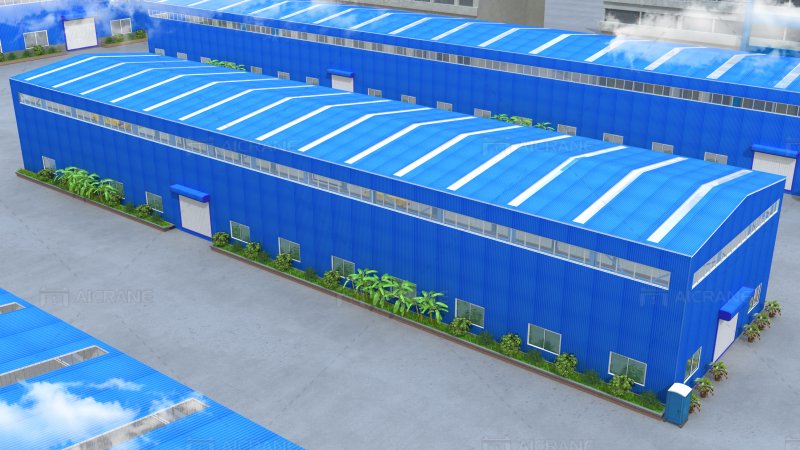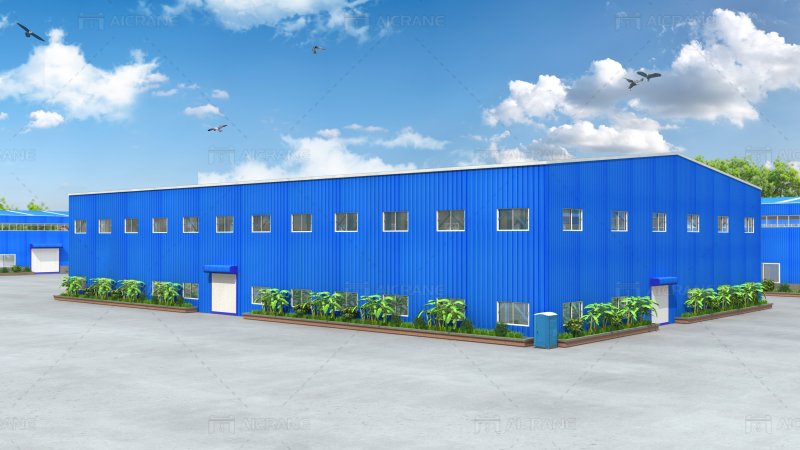In recent years, sustainable construction practices have gained prominence as industries strive to minimize environmental impact while maintaining operational efficiency. Steel structure workshops represent a significant advancement in sustainable building solutions, offering durability, flexibility, and eco-friendly attributes. This article explores how steel structure workshops, incorporating long span steel structures, provide a sustainable construction option for modern industrial facilities.

The Advantages of Steel Structures in Sustainable Construction
Steel is renowned for its sustainability credentials due to several key factors:
Recyclability: Steel is one of the most recycled materials globally, with high recovery rates at the end of a building’s life cycle. This recyclability reduces the demand for raw materials and minimizes waste sent to landfills, making steel an environmentally responsible choice.
Energy Efficiency: Steel structures can be designed to optimize energy efficiency during construction and throughout the building’s lifespan. The inherent strength-to-weight ratio of steel allows for longer spans and fewer columns, maximizing natural light penetration and reducing the need for artificial lighting and heating.
Durability and Longevity: Steel structures are resistant to corrosion, pests, and fire, ensuring a longer lifespan compared to traditional building materials. This durability minimizes maintenance requirements and operational disruptions, further enhancing sustainability by reducing resource consumption over time. Aicrane offers reliable and cost-effective steel structure solutions with various advantages to suit different needs, get to know more information about Aicrane products and solutions by checking this https://aicranemachine.com/.
Long Span Steel Structures: Enhancing Design Flexibility and Sustainability
Long span steel structures play a crucial role in sustainable construction by offering greater design flexibility and efficiency:
Design Versatility: Long span steel structures enable the creation of expansive, column-free interiors, which are ideal for workshops requiring large open spaces. This design flexibility allows for efficient layout customization to accommodate varying production needs and equipment arrangements.
Material Efficiency: The use of long span steel structures minimizes material waste and construction time compared to traditional building methods. Prefabricated steel components can be precisely manufactured off-site and assembled on-site, reducing on-site labor requirements and environmental impact.
Natural Ventilation and Daylighting: Large-span steel structures facilitate natural ventilation and ample daylighting, reducing reliance on mechanical HVAC systems and artificial lighting. This passive design approach enhances indoor air quality, occupant comfort, and energy efficiency, contributing to overall sustainability goals.

Steel Structure Solutions for Sustainable Workshops
Implementing steel structure solutions in workshop construction involves several sustainable practices:
Optimized Material Use: Steel’s high strength-to-weight ratio allows for lighter structural components, minimizing the overall weight of the building and foundation requirements. This optimization reduces the environmental footprint associated with material extraction, transportation, and construction.
Energy-Efficient Systems Integration: Integrating energy-efficient systems such as solar panels, LED lighting, and rainwater harvesting into steel structure workshops enhances sustainability by reducing energy consumption and operational costs. Steel structures provide a stable framework for supporting these technologies, optimizing their performance and longevity.
Life Cycle Assessment (LCA): Conducting a comprehensive LCA helps assess the environmental impact of steel structure workshops across their entire life cycle, from raw material extraction to construction, operation, and eventual disposal or recycling. This assessment informs decision-making processes to prioritize sustainable practices and minimize environmental footprint.
Case Studies and Real-World Applications
Several notable examples demonstrate the successful implementation of sustainable steel structure workshops:
Tesla Gigafactories: Tesla’s manufacturing facilities, including Gigafactories for electric vehicles and batteries, utilize long span steel structures to accommodate advanced production processes and maximize operational efficiency. These facilities integrate renewable energy sources and energy-efficient technologies to reduce environmental impact while meeting high-demand production goals.
Green Manufacturing Facilities: Many industries, such as aerospace and technology, are increasingly adopting steel structure workshops designed to achieve LEED (Leadership in Energy and Environmental Design) certification. These facilities prioritize sustainable building practices, including energy conservation, water efficiency, and indoor environmental quality, showcasing steel’s role in sustainable industrial construction.
Future Trends and Innovations
The future of sustainable steel structure workshops is marked by ongoing innovations and advancements:
Advanced Manufacturing Techniques: Continued advancements in prefabrication and modular construction techniques streamline the assembly of steel structures, reducing construction time and waste generation on-site.
Smart Building Technologies: Integration of IoT (Internet of Things) sensors, AI (Artificial Intelligence) analytics, and Building Information Modeling (BIM) enhances operational efficiency and resource management in steel structure workshops. These technologies optimize energy use, monitor equipment performance, and support predictive maintenance strategies.
In Summary
Steel structure workshops with long span steel structures represent a sustainable solution for modern industrial facilities seeking to balance environmental responsibility with operational efficiency. By leveraging steel’s recyclability, energy efficiency, and design flexibility, these workshops optimize space utilization, enhance indoor environmental quality, and reduce life cycle costs. As industries continue to prioritize sustainability goals, steel structure workshops will play a crucial role in achieving sustainable development and resilient infrastructure for the future.